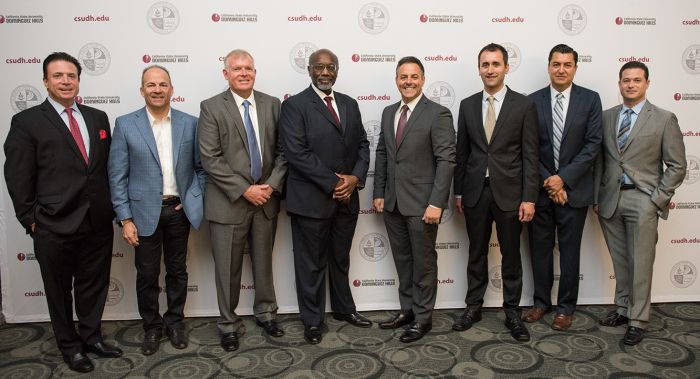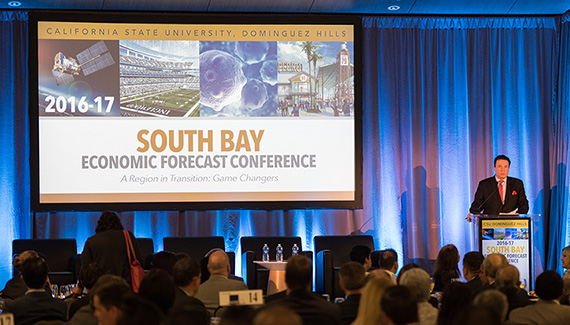
California State University, Dominguez Hills’ (CSUDH) 2nd Annual South Bay Economic Forecast Conference reported that steady growth will continue in all the South Bay’s primary economic indicators–employment, wages, housing and taxable sales–through 2017.
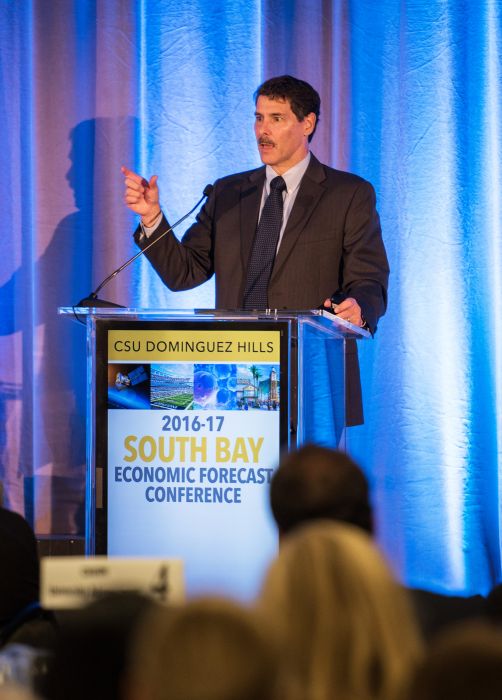
The report was presented at the 2016-17 South Bay Economic Forecast Conference on Oct. 27, which this year was titled “A Region in Transition: Game Changers.” The forecast also included presentations and panel discussions featuring local civic and business leaders discussing their companies’ research and development, and current major projects in the South Bay, such as the Los Angeles Rams’ new stadium in Inglewood and the revitalization San Pedro’s waterfront.
Robert Kleinhenz, executive director of research at the Los Angeles-based independent research and consulting firm Beacon Economics, which prepared the report for the university, offered key take-aways from the report in his presentation to the 241 business, civic, and education leaders gathered in CSUDH’s Loker Student Union ballroom. The event was hosted by Frank Mottek, anchor for KNX 1070 NEWSRADIO.
Los Angeles County is huge. It’s bigger than seven U.S. states in terms of population. That’s why it’s so important for us to try to understand what the local economy has to offer in terms of its economic base, and its employers,” said Kleinhenz.
“It’s also in the best interest of cities to know their economic base, their strengths and weaknesses, and the synergies they have with other communities, and there is not a better place than this university to really bring attention to all that the region has to offer.”
Read the entire South Bay Economic Forecast report here.
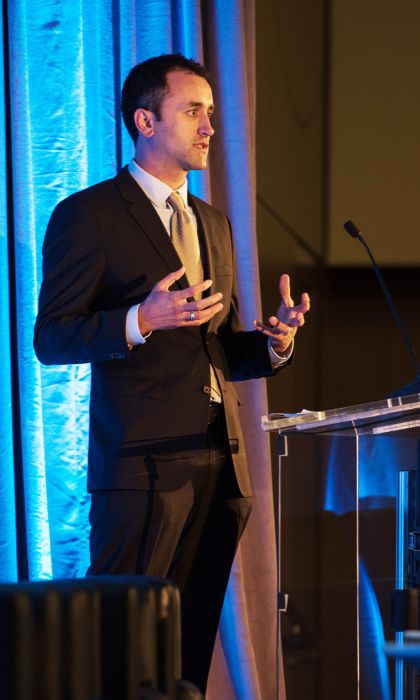
The 44-page economic report shows that in 2017 the South Bay’s total employment in its incorporated cities is estimated to rise from 1.6 to 1.8 percent, or 10,108 jobs; payroll of workers will increase from 4.0 to 4.1 percent; and taxable sales will markedly increase from 2.5 to 4.1 percent, or by $537 million. While the South Bay housing market is still suffering from a supply shortage, housing permits were up substantially from -12.3 in 2016 to 32.3 in 2017. Home sales also jumped in 2016 and more growth is expected in 2017.
Employment opportunities also looked promising and were up in the South Bay by 12,700 jobs in 2015, or 2.4 percent, unemployment was down in all cities, while population growth had decreased from 0.5 to 0.2 percent.
The forecast also included detailed reports on each South Bay city regarding ethnicity, educational attainment, travel time to work, and summarized the overall economic outlook for the state and nation. California has stayed on course with a solid economic performance through the first three quarters of 2016, despite slower growth nationally.
The morning conference also included a presentation by CSUDH faculty. Jose Martinez, assistant professor of economics and co-director of CSUDH’s Economic Institute, which was established in February 2016, provided an update of the South Bay housing market, and employment distribution. He also addressed implications for educational attainment requirements for workers in Los Angeles. Fynnwin Prager, assistant professor of public policy and co-director of the institute, focused in part on the economic impact model that the institute is developing for the South Bay.
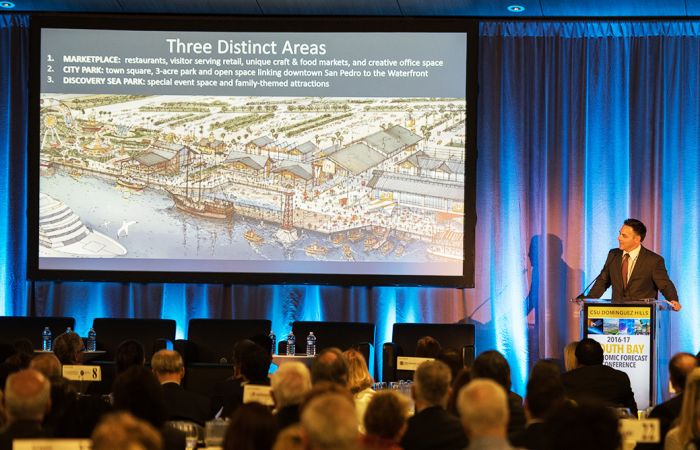
“We are developing a model of the South Bay economy so that we can better understand the impact of economic changes, such as those in our industries, cities, and households. It can also look at the economic impact of new or potential policies being implemented, our region’s unique position with respect to the Port of Los Angeles, and our integration into the Pacific Rims’ vibrant economy,” said Prager. “The model could also capture [effects of] policy reforms, such as changes to minimum wage laws, and economic shocks and game changers, such as the benefits of a new professional sports team to the region, and the impact of extreme events, such as earthquakes, terrorist attacks, and infrastructure failings.”
Game Changers
“Were it a county in its own right, the South Bay would be the 10th largest county in California,” said CSUDH President Willie J. Hagan. “The report tells a story of transition and of economic diversification, with growth in tech start-ups, creative industries, medical device manufacturers, and pharmaceutical companies joining the long-dominant industries of our economy.”
The LA Rams new stadium in Inglewood, and the San Pedro Market Place are two of the largest and most anticipated construction projects in the South Bay. Joe Buscaino, Los Angeles city councilman (15th District), presented an overview of $150 million redevelopment of Ports O’Call in San Pedro, as well as what developers are planning for the project, and what it will offer visitors, residents, and the region.
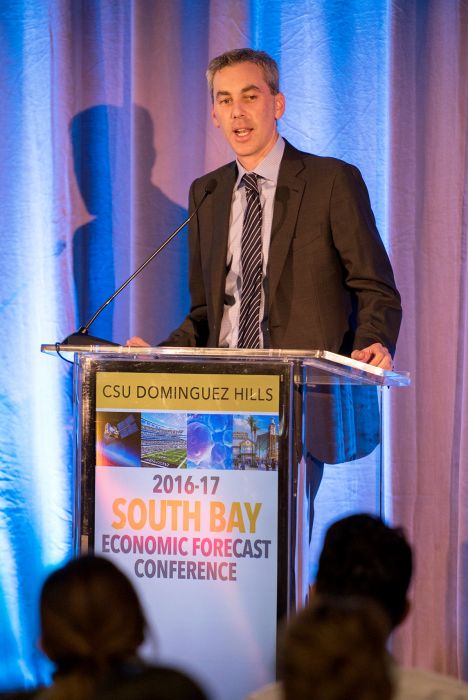
Kevin Demoff, executive vice president and COO of Football Operations for the Los Angeles Rams, discussed the new NFL stadium and its regional impact–from a destination and economic perspective in regards to jobs, to the vision for the team and the stadium–and how the organization is engaging the community. The 298-acre project will include the 70, 240-seat stadium, 1 million square feet of office and retail space, and create more than 3,300 permanent jobs.
“We look at the project as a connecting point for the South Bay to what lies to the north, such as the airport, Playa Vista, and Culver City and what’s happening there. What this project can become is really a destination for everyone in this area,” said Demoff. “Like the project in San Pedro, we have thought about the kinds of places people want to go–where they can walk around and have great experience. We will have 15 acres of parks, so it’s also a place you can go and enjoy time with the family on Saturday, then cheer on the Rams on Sunday.”
Other top industry leaders who presented during the forecast were Vince Deno, COO of Millennium Space Systems in El Segundo, who highlighted the company’s affordable, high-performance satellites, the economic impact of the industry, and the tangible day-to-day products made possible by space-related research and development. Scott Alderton, a technology lawyer and partner at the law firm Stubbs Alderton & Markiles, LLP, focused on such topics as the clash between policy and technology for startup companies, with a particular focus on the Jobs Act, and the phenomena of crowdfunding for technology companies.
Paul Jenkinson, CFO for Kite Pharma, discussed the company’s breakthrough therapy for non-Hodgkin lymphoma that has increased the disease’s only 8 percent recovery rate by “fivefold” in clinical trials. He covered Kite Pharma’s “ground-swell of support” and the economic opportunities for medical research companies in the South Bay and LAC.
“Kite Pharma is dedicated to achieving one of the most ambitious goals of 21st century medicine: curing cancer,” said Jenkinson. “We are in the forefront of cancer immunotherapy with what is potentially the biggest breakthrough since the introduction of combination chemotherapy more than 60 years ago.”
